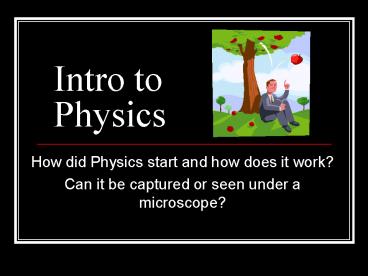Intro to Physics PowerPoint PPT Presentation
1 / 20
Title: Intro to Physics
1
Intro to Physics
- How did Physics start and how does it work?
- Can it be captured or seen under a microscope?
2
Physics is the study of the physical universe.
- Some branches of Physics
- a. Optics (the study of light)
- b. Electromagnetism (the study of electricity and
magnetism) - c. Thermodynamics (the study of heat)
- d. Mechanics (the study of motion)
THIS ONE IS WHAT WERE STUDYING!
3
- Though physics is definitely a branch of
- , it will sometimes feel like were
- in a class, because of all of the formulas
and problem-solving.
science
math
4
Speed and Velocity
- Speed is defined as
- Rate of change of position
- Velocity is simply
- Speed with a direction
5
The defining formula for speed/velocity is
distance traveled
d
___
v
t
time interval
speed or velocity
6
Standard units of measure for speed/velocity
- Meters/second (m/s)
- But we can also use others
- km/hr
- miles/hr
7
- Ex 1 A woman runs a distance of 100 meters in
a time of 25 seconds. What is her speed? - 4 m/s
8
- Ex 2 A plane flies at a speed of 200km/h. How
far does the plane go in 15 minutes? - 50 km
9
Isaac Newton
- Though motion has been studied for thousands of
years, Isaac Newton (1643-1727) is credited with
beginning physics in the way we study it now.
Hes often thought of as the most influential
scientist ever! (Even more important than
Einstein!) - Theres a famous story that Newton saw an apple
fall to the ground, and he wondered if the cause
of the apples fall was the same reason that the
moon stayed in orbit. - He tried to explain all of those motions with the
idea of forces.
10
Forces Push or Pull?
- A force can be described as a push or pull.
- Standard units of measure for forces Newtons
(N). - 1 N 1kg m/s2
- 1 N 0.225 lbs
11
- There are forces acting on us all the time.
- a. Gravity is pulling down on you.
- b. Air pressure is pushing on us while our
bodies push back.
12
Newtons 3 laws of motion
- First Law
- An object will continue in its present state of
motion (or rest), unless it is acted upon by a
net force. - Net force total of all forces acting on an
object
13
Newtons 3 laws of motion
- Second Law
- A net force will make an object accelerate. The
size of the acceleration depends on the strength
of the force and the mass of the object.
14
Newtons 3 laws of motion
- Third Law
- For every action force, there is an equal and
opposite reaction force.
15
Newtons 1st Law (Revisited)
- The easy example An object sitting still will
only start moving if - A net force makes it start moving
16
Newtons 1st Law (Revisited)
- The more difficult example An object in motion
will only change its motion if - A net force makes it speed up or slow down.
- So why do most objects seem like they have a
natural tendency to slow down and stop? - Friction provides a net force, which stops the
object.
17
Newtons 1st Law (Revisited)
- Newtons 1st Law is sometimes known as the law of
inertia. - Inertia is defined as the tendency of objects to
continue their motion, and mass is a measure of
an objects inertia
18
Newtons 1st Law (Revisited)
- Ex 3 Correct the following statement An
object will only move if a net force acts on it. - An object will only accelerate (or change
motion) if a net force acts on it.
19
- Ex 4 Two forces are pulling on an object in
opposite directions, as shown in the diagram.
The object is at rest and is continuing to stay
at rest. Find the size of F2 if F1 300N.
F1 300N
F2 ?
20
- Ex 4 Answer
- Because the object is at rest, there must be
zero net force on the object. - So F2 must also equal 300N, for the net force to
equal zero.
F1 300N
F2 300N

